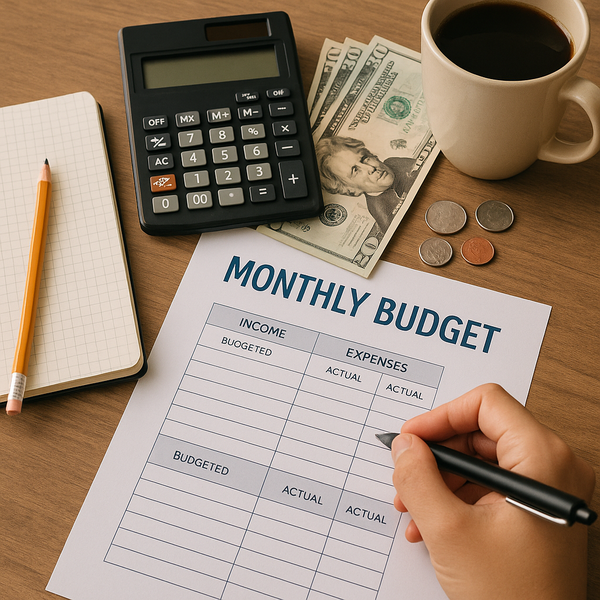
Creating a monthly budget is a fundamental step towards achieving financial stability and peace of mind. It acts as a roadmap, guiding your spending and saving habits to align with your financial goals. By understanding where your money goes each month, you gain control and can make informed decisions about your finances, paving the way for a more secure future.
Understanding the Purpose of a Budget
Before diving into the mechanics of creating a budget, it's essential to understand why it's so crucial. A budget isn't about restricting yourself unnecessarily; it's about empowering you to make choices that serve your long-term goals. It helps you identify wasteful spending, allocate funds towards savings or debt repayment, and prevents unexpected expenses from derailing your finances. Think of it as a tool for financial freedom, not financial constraint.
Gathering Your Financial Information
The first practical step in creating your monthly budget is to gather all your relevant financial information. This includes income from all sources (salary, side hustles, benefits, etc.) and a comprehensive list of all your expenses. Go through bank statements, credit card bills, receipts, and any other financial records from the past few months, ideally three months, to get an accurate picture of your spending habits. Categorize these expenses as fixed (rent, mortgage, loan payments, insurance) and variable (groceries, entertainment, utilities, transportation).
Calculating Your Monthly Income
Next, determine your total monthly income after taxes. This is often referred to as your net income or take-home pay. If your income varies from month to month, calculate an average based on your records from the past few months, or use a conservative estimate to avoid overspending. Be realistic and only include income that you can reliably expect to receive each month.
Tracking and Categorizing Expenses
Accurately tracking your expenses is perhaps the most critical part of budgeting. Use the information you gathered to list out everything you spend money on. Assign each expense to a category. Common categories include housing, transportation, food, utilities, insurance, debt payments, savings, personal care, entertainment, and miscellaneous. Be as detailed as possible in this step; small, frequent purchases can add up quickly and significantly impact your budget.
Comparing Income and Expenses
Once you have a clear picture of your total income and total expenses for the month, the next step is to compare them. Subtract your total expenses from your total income. Ideally, your income should be greater than your expenses, leaving you with a surplus. If your expenses exceed your income, you have a deficit, and you'll need to make adjustments. If you have a surplus, you can decide how to allocate those extra funds towards savings, investments, or debt reduction.
Creating Your Budget Plan
Now it's time to formalize your budget plan. There are various budgeting methods you can use, such as the 50/30/20 rule (allocating 50% of income to needs, 30% to wants, and 20% to savings/debt repayment), the zero-based budget (assigning every dollar of income to a specific category), or a simple envelope system. Choose the method that best suits your personality and financial situation. Allocate specific amounts to each spending category based on your income and historical spending, making adjustments to ensure your plan aligns with your financial goals.
Setting Financial Goals
Creating a budget is more effective when tied to specific financial goals. These could be short-term goals like building an emergency fund, saving for a vacation, or paying off a credit card, or long-term goals like saving for a down payment on a house, retirement, or your children's education. Having clear goals provides motivation and direction for your budgeting efforts, helping you prioritize where your money goes.
Choosing Budgeting Tools and Apps
Managing your budget can be made easier with the right tools. Options range from simple spreadsheets and printable templates to sophisticated budgeting apps and software. Many apps can link directly to your bank accounts and credit cards, automatically tracking and categorizing your spending. Find a tool that you find easy to use and that helps you stay organized and motivated.
Monitoring and Adjusting Your Budget
Creating a budget is not a one-time task; it requires ongoing monitoring and adjustment. Life changes, income fluctuates, and unexpected expenses arise. Review your budget regularly, at least once a month, to see how you're tracking against your plan. Identify areas where you overspent or underspent and understand why. Make necessary adjustments to your budget categories and allocations to reflect your current situation and ensure you stay on track towards your goals.
Staying Disciplined and Patient
Successfully sticking to a budget requires discipline and patience. There will be months where you might struggle to stay within certain categories, and that's okay. The key is to be aware of it, learn from it, and get back on track the following month. Celebrate small wins and remember why you started budgeting in the first place. It's a journey, and consistency is more important than perfection.
Building a monthly budget is a powerful habit that provides clarity, control, and confidence in your financial life. By following these steps, gathering information, setting goals, choosing the right tools, and committing to regular review, you can create a sustainable budget that supports your journey towards financial well-being and helps you achieve your aspirations.

